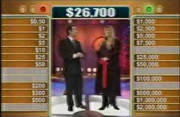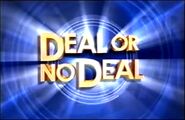Deal or No Deal is a game show presented by Andrew O'Keefe and Grant Denyer.
Introduction[]
DOND AUS was the first international version of Deal or No Deal, being only the second version of the show, (The Netherlands being the first; to see that article, please click here). It started on Seven Network in 2003, hoping to aim big with a prime-time slot challenging Nine Network's Who Wants to Be a Millionaire (which itself had just come over from the UK).
Game Board[]

A picture of the board used during the $12,000,000 Month/Primetime Specials, with six amounts removed.
There are many versions of the game board, since the show has evolved. Here are all the versions:
2003[]
| $0.05 | $1,000 |
| $0.25 | $2,500 |
| $0.50 | $5,000 |
| $0.75 | $7,500 |
| $1 | $10,000 |
| $5 | $25,000 |
| $10 | $50,000 |
| $25 | $75,000 |
| $50 | $100,000 |
| $75 | $250,000 |
| $100 | $500,000 |
| $250 | $1,000,000 |
| $500 | $2,000,000 |
2004[]
| $0.50 | $1,000 |
| $1 | $1,500 |
| $2 | $2,000 |
| $5 | $3,000 |
| $10 | $5,000 |
| $25 | $7,500 |
| $50 | $10,000 |
| $75 | $15,000 |
| $100 | $25,000 |
| $150 | $50,000 |
| $250 | $75,000 |
| $500 | $100,000 |
| $750 | $200,000 |
2005[]
| 50c | $1,000 |
| $1 | $1,500 |
| $2 | $2,000 |
| $5 | $3,000 |
| $10 | $5,000 |
| $25 | $7,500 |
| $50 | $10,000 |
| $75 | $15,000 |
| $100 | CAR |
| $150 | $50,000 |
| $250 | $75,000 |
| $500 | $100,000 |
| $750 | $200,000 |
2006-2013[]
| 50c | $1,000 |
| $1 | $2,000 |
| $2 | $3,000 |
| $5 | $4,000 |
| $10 | $5,000 |
| $20 | $10,000 |
| $50 | $15,000 |
| $100 | $20,000 |
| $150 | CAR |
| $200 | $50,000 |
| $250 | $75,000 |
| $500 | $100,000 |
| $750 | $200,000 |
2024-present[]
| 50c | $1,000 |
| $1 | $2,500 |
| $5 | $5,000 |
| $10 | $7,500 |
| $25 | $10,000 |
| $50 | $20,000 |
| $75 | $30,000 |
| $100 | $40,000 |
| $250 | $50,000 |
| $500 | $75,000 |
| $750 | $100,000 |
- (CAR (Peugeot 307) valued at $30,000)
The Game Structure[]
The structure of the current show is not very simple.
Preliminary round[]
The show begins in a studio with six groups of 25 people sitting in stands. One group is then randomly selected, plus one additional person from the remaining groups. In the chosen group, one person, based on personality, is picked to be the main contestant. The contestant selects one of the briefcases to be placed at the front, and the other briefcases are distributed to the other 25 contestants on the podium.
In 2003, the preliminary round went for longer. Instead of randomly selecting a block of 25 people, the members of the eight blocks collectively competed against each other in a short quiz to determine which group would get selected. Also, rather than choosing the sole fastest contestant in the individual question round, the two fastest contestants were chosen to compete head to head in answering one final question before the eventual victor proceeds to the main game. This format was similar to the preliminary round of Miljoenenjacht.
In 2004 to 2006, all 26 contestants then moved onto the podium, where they had to answer three multiple choice questions, each question worth 10 points. After the three questions, whoever had 30 points, and answered the questions the quickest, got to play for the money.
The contestant chosen is shown twenty-six numbered briefcases held by identical models (similar to other versions; with dresses and wigs), each containing a hidden amount of money.
Opening the cases[]
The contestant begins the game by opening six cases. To open the case, the podium player holding the case must first guess the amount that they have in their briefcase, winning $500 if their guess is proved correct upon opening the briefcase (From 2004-2006, the correct guess was worth $1,000, excluding megaguesses). This process is repeated for the next five cases. After the first five cases, the major contestant is given a "Bank Offer", which is a certain amount of money. The contestant now has to decide between a "Deal" or "No Deal". If the contestant says Deal, they win the money that is offered, and they must open the rest of the cases. If the contestant says No Deal, then gameplay continues. The list below explains how many cases must be opened for each round:
- Round 1: 6 cases to open
- Round 2: 5 cases to open
- Round 3: 4 cases to open
- Round 4: 3 cases to open
- Round 5: 2 cases to open
- Round 6-9: 1 case to open (Depending on when/if a deal is taken)
Bank Offers[]
The Bank Offers are based on, but not equivalent to, the of the remaining briefcases. That is, if there are mainly large valued briefcases remaining, then there is a high chance that the contestant's briefcase is valuable, and so the Bank Offer will be generous. Conversely, if the player has been less fortunate and opened the more valuable briefcases, then the Bank Offer will be low.
End of game[]
If the player continues to the end without making a "Deal", the game ends with their own briefcase being opened and the amount in that briefcase being won, otherwise they win the offer they said "Deal" to. Exceptions to the end of the game include the introduction of either a Supercase, Double or Nothing cases or a second Chance.
Features[]
Deal or No Deal has a number of special features that have been introduced since the show started. A number of these are endgame features which occur after the player takes a deal, but others have other requirements for activation.
Daily Prize[]
The Daily Prize is a feature that was introduced in 2004, where one of the briefcases (with the blue background) except the ones containing the CAR prize or the $100,000 or $200,000 (green coloured background) also contained gold stars. The holder of this case, regardless of being the main player or a podium player, wins $500. The Daily Prize was removed as a regular feature in 2006, however it did return on special occasions that year, such as a Saint Patrick's Day-themed episode, a Mother's Day-themed episode and during the final week of the year.
Super Case[]
The Super Case is an endgame feature introduced in 2004 where an extra large prop case is revealed containing an extra cash value between 50 cents and $50,000, or up to $30,000 on Double Deal Friday. The Super Case occurs most often when the player has taken a deal worth approximately $10,000 with at least five cases left on the board. This generally means that the Super Case offers a 50/50 chance at equalling or bettering the offer, because four out of the eight possible values are $10,000 or better. During the 2006 season, the Super Case alert changed from a panel at the top of the screen to a little indicator beside the "Cases remaining" counter, this remains shown until the feature is actually activated.
Chance[]
The Chance is an endgame feature introduced in 2004 where the player is given an opportunity to rescind their deal and take the amount that is in their case. The Chance is only offered rarely if the last two amounts on the board are a small amount and an amount at least $5,000. For example, if a player has taken a deal for $6,500, but the last two amounts on the board are $750 and $10,000 they could be offered the Chance. If the player takes the Chance, they win whichever amount is inside their briefcase, otherwise they keep their $6,500 deal.
Mega–Guess[]
The Mega–Guess is a feature introduced during the $12 Million Month in 2004 that increases the value of the bonus money given to the next podium player if they correctly guess the contents of their case. Since 2006, the Mega-Guess has $2,000, $5,000 and $10,000 variants, the $5,000 is the most common (sometimes used multiple times in a game), followed by $10,000 (usually appears early in a game) and $2,000 (often appears for podium players celebrating birthdays or from outside Victoria where the show was filmed). It often happens when the podium player is a friend or relative of the main player. The Mega-Guess has developed as a small gag where either O'Keefe, the main player or the podium player would beg the unseen banker character to give the player a Mega-Guess.
The Mega-Guess originally had a fixed prize of $10,000, however when it returned in 2005 it was reduced to $5,000. A $25,000 Mega-Guess was offered to the player holding the 25,000th case to be opened in the show's history, however it wasn't won.
Double Deal Friday[]
Double Deal Friday was a feature introduced in 2005, where viewers could register via premium-rate telephone number to go into a draw to win the same prize as the main studio player on that Friday's episode. A similar format, called Dancing with the Deals, featured contestants from Dancing with the Stars, but in that version the studio player did not win the prize, only the home viewer won. Double Deal Friday ended in 2008.
Double or Nothing[]
Double or Nothing is an endgame feature introduced in 2006 where the player is given an opportunity to choose between two cases that each contain either "Double" or "Nothing". If the player decides to play Double or Nothing, then they will either win double their deal amount or go home with no money.
The original format had Double or Nothing presented in a large case much like Super Case and the player could choose how much of their deal to gamble on the contents of the single case. The two cases format was introduced on 23 June 2006, and by 2007 the player could no longer choose how much to gamble, and must wager their entire deal.
Risk It All[]
Risk It All is an endgame feature introduced in 2010, which is offered to a player who has taken a deal under $10,000, but has two smaller amounts left in play. If the player decides to play, they must predict which of the two amounts is in their case. If they are correct they win $15,000, otherwise they lose their entire deal.
Switch Case[]
Switch Case is a feature introduced in 2010 where the bank will offer the player a chance to switch their briefcase with any unopened briefcase on the podium, and generally occurs in the middle of the game.
Dash for Cash[]
Dash for Cash is an endgame feature introduced in 2013 where the player is given a special offer of approximately half of the maximum prize available at that point, and is offered if that maximum prize is $5,000 or less. If the player takes this special deal then the game ends immediately and no further cases are eliminated.
Second Chance[]
The Second Chance is an endgame feature introduced in 2013 where the player is given an opportunity to switch the deal with one of the previous offers made earlier in the game, selected at random. When it is activated, a model will give a button to the contestant, which is pressed to confirm their decision to take the switched deal.
In popular culture[]
Andrew O'Keefe appeared as himself in an episode of the Australian sitcom Kath & Kim called "House" (Season 4, Episode 5) from 2007, reprising his role as host of the show. In the episode, Sharon Strzelecki (Magda Szubanski) appeared as the main contestant while Kim Craig (Gina Riley) appeared as her podium partner. Strzelecki wins $20,000 from her case (though footage of her winning is never shown). The gameplay shown has some minor changes compared to the actual game show airing at the time: Craig wasn't given the opportunity to make a guess for the contents of her case before opening it, and Strzelecki claims that she became the main contestant by having the "fastest fingers" (the preliminary quiz was dropped from the 2007 season, and the fictional game shown was of that version). O'Keefe also references the timeslot the show airs in by saying that it's "almost news time", a Seven News update would air in the final minutes of an actual game, which is followed by the news broadcast.
NOTE: Szubanski would later go on to host a short-lived revival of The Weakest Link on Nine Network in 2021 until 2022.
Products[]
Products based on Deal or No Deal include a board game, video game, electronic game and a DVD game.
The board game, made by Crown and Andrews, features all parts of the game show, and is based on the 2004 season. The contents include 26 briefcases (a flat item with a number and a slot to hide the card of the cash amount), the board showing the amounts, 26 covers for the board, host and contestant cards, amount cards, instructions and money. An updated version was eventually released, based on the later seasons of the show.
The video game, available only for Nintendo DS, was developed by Gravity-i and published by Mindscape and features Andrew O'Keefe on the cover. The game uses the same engine as the British version of the same title, but with changes to make it more faithful to Australian game show, such as replacing the British boxes with the gold briefcases.
Gameloft developed and release a mobile version of this game, along with the British, German, Spanish and Poland version of Deal or No Deal.
Trivia[]
- The cars were added in 2005 and are both worth around $30,000 dollars. The cars have been offered are as follows: the Peugeot 307 from 2005-2007 (briefly replaced by the Renault Mégane II in 2005), the Peugeot 306 in 2008, the Peugeot 207 in 2009, the Peugeot 206 in 2010 and the Peugeot 207CC from 2011-2013.
- No one won the $2,000,000 prize.
- On the show's first ever episode (13/7/03), the first case (#11) that was opened contained $2,000,000.
- There have been four people who have won the $200,000 top prize, one of which was a celebrity.
- In 2004, a series of primetime specials entitled the $12,000,000 Month aired. In these specials, a modified version of the 2003 board was used ($0.05, $0.25, $0.75, $250 removed, $2, $200, $300, $750 added) and was updated to the 2004 graphics.
- The highest amount of money given away on the show is $515,000 by Nathan Cochrane.
- When the Fantastic Four special airs, the corners of the board changed from 50 cents to $50,000, $750 to $75,000, $1,000 to $100,000 with the $200,000 remains unchanged, but when it first aired back in 2009, the $200,000 changes to $250,000.
- Before it was settled that Denyer was going to host the DOND reboot on Network 10 in 2024, on 2 October 2023, it was rumored that talk show and current affairs Gold Logie award-winning television and radio presenter Carrie Bickmore[1]was in the running to host the upcoming reboot.
Logos[]
| This page uses Creative Commons Licensed content from Wikipedia (view authors). | 
|




